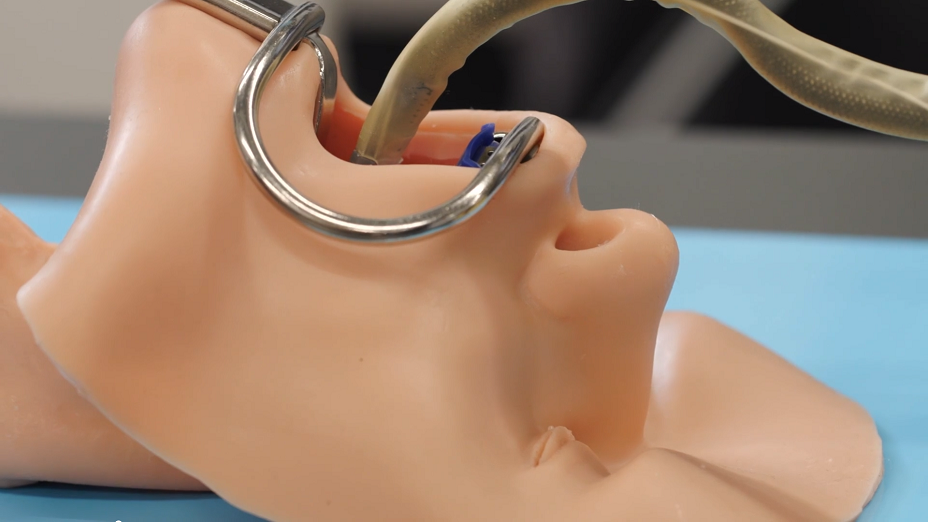The COBRA robot, taking inspiration from the bendiness and sensing ability of snakes, has been developed at the University of Nottingham and is now being refined for medical use.
Based in the Rolls-Royce University Technology Centre (UTC) in Manufacturing and On-Wing Technology at the University, COBRA’s researchers are the only group in the world to have perfected this kind of remote-controlled technology for industry.
It has previously been successfully demonstrated in jet engine inspection and repair as well as nuclear plant installation and maintenance.
The UTC has now secured Engineering and Physical Sciences Research Council Impact Accelerator funding to adapt COBRA into the first robot in the UK specifically for throat cancer and injury surgery.
Such kinds of medical procedures are currently performed with endoscopic tools, but COBRA could offer more dexterity, accuracy, and high-definition views for surgical teams.
“We have started early tests to see if the robot can navigate and has enough motion capabilities to perform surgical procedures,” explains UTC Director, Professor Dragos Axinte. “For medical applications there are a lot of safety adjustments to make on the design and control method of the probe to make it suitable for inspecting inside the human body. The robot has potential in a broad range of applications and medicine is an exciting direction for our research to take.”
The design
The ‘snake’ robot is 9mm in diameter, about the same thickness as a pencil, and is 5m long. It features a series of tendons along its ‘backbone’ – a compliant-joint structure and multiple continuous sections that enable it to bend at around 90°. When these tendons are pulled (by remote commands) it drives the bending motions – mimicking the range of movements of a human operator’s hands when handling the repair tools. The snake-arm can be different widths and has a hollow interior, through which different tools or instruments can be fitted.
All of the above means it can easily slither through crammed spaces and round tight bends.
COBRA is easily operated remotely after only a few minutes of training via a controller (much like a large gaming joystick). It is currently equipped with a stereovision camera and a miniature cutting tool attached to the ‘head’ of the snake (an end-effector); however, other devices to mend or monitor can be interchanged, depending on the task required.
Applications
Preliminary studies for COBRA’s medical use have now been carried out with Dr Oladejo Olaleye, a Consultant Ear, Nose and Throat and Robotic Surgeon at University Hospitals of Leicester NHS Trust.
COBRA was tested on a human dummy to access hard-to-reach parts at the back of the throat via the mouth – locations currently inaccessible without highly invasive surgery. The high-definition camera provided excellent views of the throat displayed on an operating screen.
Given that the robot is deliberately so easy to manipulate, it took only five minutes of training for the consultant to carry out the demonstration at the UTC laboratory. The robot was manoeuvred round bends using a hand-held drive and locked into positions in the throat to achieve optimal operating views for the surgeon.
Dr Oladejo Olaleye believes COBRA is “the interface between engineering and medical surgery” and “the future of diagnostic endoscopy and therapeutic surgery” providing a viable and minimally invasive option both for making diagnoses and treatment of diseases in the throat, chest, or bowel.
“COBRA’s strengths include a flexible construct, ability to bend and hold in position, high-definition views, ease of adaptation and portability. Achieving clear views of throat and voice-box cancers will hopefully translate into full clearance of the tumours with less pain, quicker recovery from hospital, improved survival, and better rehabilitation outcomes for our patients,” said Dr Oladejo Olaleye, Consultant Ear, Nose and Throat and Robotic Surgeon at University Hospitals of Leicester NHS Trust.
The next steps for COBRA are a series of validation studies before clinical trials take place to translate the robot’s design into medical practice.
The researchers are also considering another potential application for the robot – disaster rescue.
“The snake arm robot is the ideal design to explore tight spaces inside collapsed structures or a caving accident, for instance. It could really help in the search for survivors, especially where its hazardous for rescuers. With a carbon dioxide detector attached to the tip of its probe it could pick up human breathing and a camera could report back visual updates. Additional pipes connected to the length of the robot could also provide anyone trapped or injured with vital oxygen and water supplies,” said Professor Axinte.
Image courtesy of the University of Nottingham
For more medical stories, check our Healthcare for plenty of related content. There’s also other industry editorial at IoT Insider’s sister publication, Electronic Specifier.
And you can always add to the discussion at our comments section below or on our LinkedIn page here.
